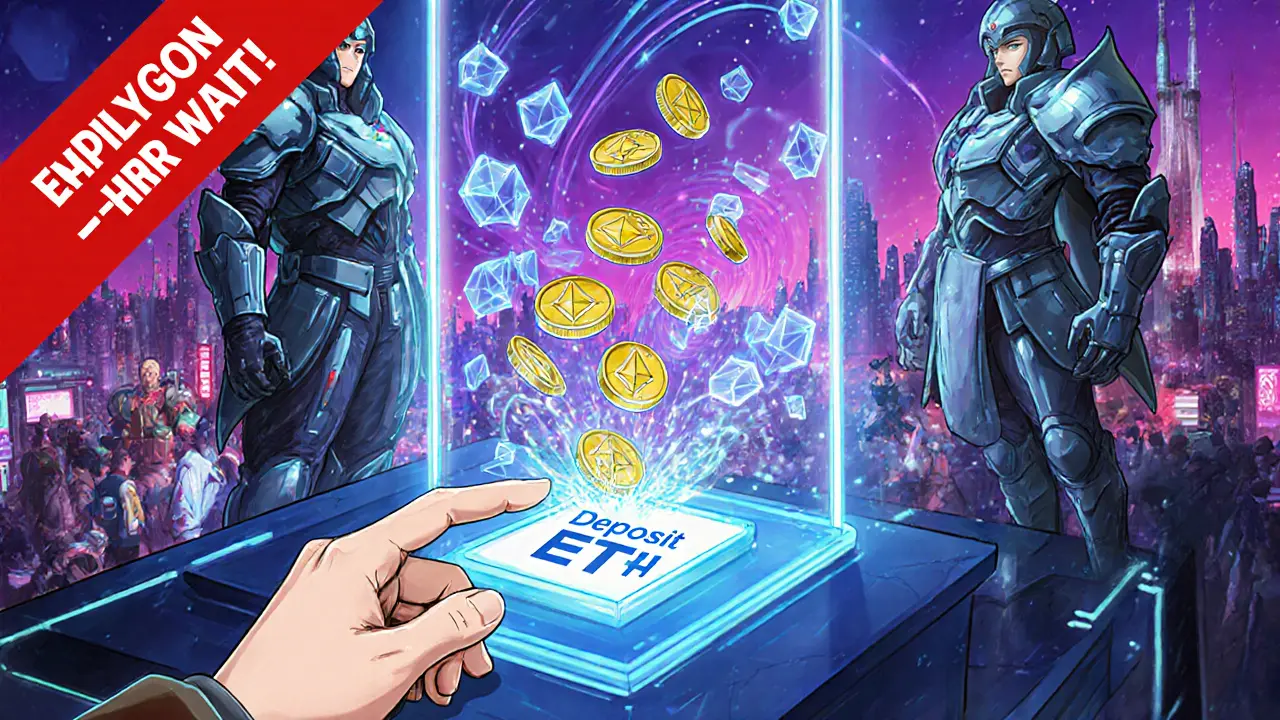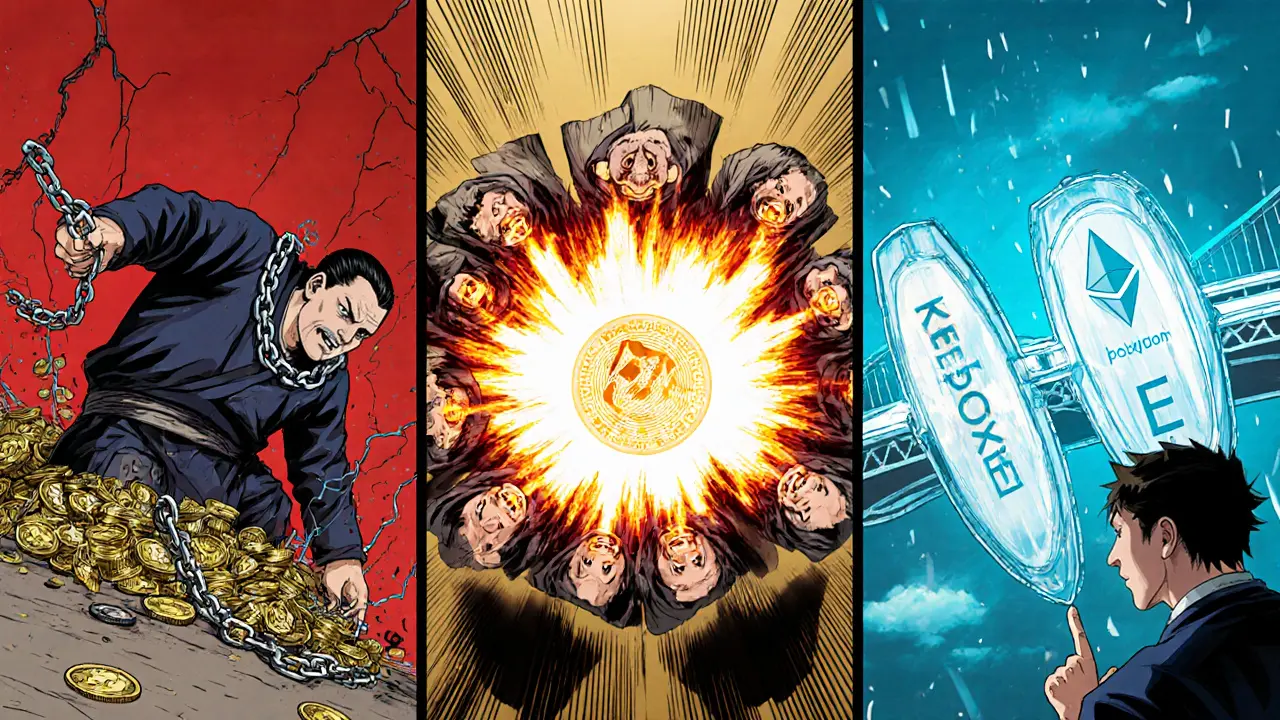Sidechain Transaction Cost Calculator
Ethereum Mainnet: $1.20 per transaction
Polygon Sidechain: $0.0001 per transaction
Other sidechains: $0.0002 to $0.001 per transaction
* Costs may vary based on network congestion
When you send ETH from Ethereum to Polygon, it doesn’t just disappear and reappear. There’s a complex, carefully designed system making that happen - and if you don’t understand how it works, you’re trusting something you can’t see. Sidechains aren’t magic. They’re engineered solutions to a real problem: main blockchains like Ethereum are slow and expensive. Sidechains fix that - but they do it by creating a bridge, and bridges can break.
What Exactly Is a Sidechain?
A sidechain is its own blockchain. It runs independently. It has its own validators, its own rules, its own speed. But it’s connected to a main blockchain - usually Ethereum or Bitcoin - through a two-way peg. That means you can move assets back and forth between them. The key word here is connected, not part of. A sidechain doesn’t inherit the mainchain’s security. It borrows trust, sometimes reluctantly. The idea was laid out in a 2014 paper by Blockstream engineers. Back then, Bitcoin was struggling with slow transactions and high fees. Ethereum wasn’t even fully live yet. The goal was simple: let developers build applications without clogging the main network. Today, sidechains like Polygon, Ronin, and Arbitrum (though technically a rollup) process millions of transactions daily. Polygon alone handles over 1.2 million daily transactions, at a cost of about $0.0001 per transaction. On Ethereum mainnet? That same transaction would cost around $1.20.The Two-Way Peg: How Assets Move Between Chains
This is the core mechanism. When you lock ETH on Ethereum to get wETH on Polygon, you’re not sending coins. You’re locking them. Here’s how it works step by step:- You initiate a transfer through a bridge interface - say, the official Polygon bridge.
- Your ETH is sent to a smart contract on Ethereum:
0xA0c68C638235ee32657e8f720a23ceC1bFc77C77. - The contract locks your ETH. It can’t be spent or moved until the process completes.
- After 100-200 Ethereum block confirmations (about 25-50 minutes), a checkpoint is created.
- Polygon’s validator set verifies this checkpoint using Merkle proofs - cryptographic evidence that your transaction happened.
- Once verified, Polygon mints an equivalent amount of wETH on its chain.
How Bridges Actually Work: Three Types of Connections
Not all sidechains connect the same way. There are three main models:- Federated bridges - like Ronin. A small group of trusted nodes (in Ronin’s case, 9 validators) approve transfers. Fast, but centralized. If those 9 get hacked - as happened in March 2022 - $625 million vanishes.
- Proof-of-Stake bridges - like Polygon. Hundreds of validators stake tokens (MATIC) as collateral. They’re incentivized to act honestly because if they cheat, their stake gets destroyed. Polygon uses 100 validators, requiring 67% consensus to confirm checkpoints.
- Trustless bridges - the ideal. These use cryptographic proofs without relying on trusted parties. Think zero-knowledge proofs or fraud proofs. These are harder to build. Most current bridges aren’t fully trustless - they’re trust-minimized.

Security Trade-Offs: Why Sidechains Aren’t as Safe as Ethereum
Ethereum has over 800,000 validators securing the network. Polygon has 100. That’s a 8,000x difference in decentralization. That’s not a bug - it’s a design choice. The University of California, Berkeley found that sidechain bridges were the target of 65% of all cross-chain hacks between 2020 and 2023. Total losses? $2.8 billion. The Ronin hack alone wiped out $625 million. Why? Because the bridge - not the chain itself - became the weak point. Vitalik Buterin put it bluntly: sidechains offer valuable scaling, but they’re not equally secure. They’re a different risk-reward tradeoff. If you’re trading NFTs in a game or paying for in-game items, a $0.0001 fee is worth the slightly lower security. If you’re moving $5 million in stablecoins? That’s a different story.Real-World Use Cases: Where Sidechains Shine (and Fail)
Sidechains aren’t for everything. They’re perfect for:- Gaming - Immutable X handles 9,000 NFT trades per second for Gods Unchained. No way that’d work on Ethereum.
- Microtransactions - Decentraland moved its land sales to Polygon in 2022. Fees dropped from $45 to $0.03. Daily active users jumped from 2,300 to 12,000.
- Developer prototyping - Building on Polygon is 10x cheaper than Ethereum. Startups use it to test ideas before going mainnet.
- High-value settlements - No one should use a sidechain to settle a $10 million trade. Too much risk.
- Long-term custody - If you’re holding crypto for years, keep it on Ethereum or Bitcoin. Sidechains are for movement, not storage.

What Goes Wrong: Common Bridge Problems
Even the best bridges have issues. Developer feedback on GitHub shows:- 28% of issues are stuck deposits - your ETH is locked, but Polygon hasn’t minted the tokens.
- 22% are failed withdrawals - you burned wETH, but your ETH never arrived.
What’s Changing in 2025?
Sidechain tech isn’t standing still. Here’s what’s new:- Polygon Supernet - Launched in September 2023, it lets companies build their own custom sidechains with dedicated bridges. Think of it as a sidechain factory.
- Ethereum’s Proto-Danksharding (EIP-4844) - Coming in Q1 2024, this will cut bridge costs by 90% by making data cheaper to store on Ethereum. That could reduce the need for sidechains for some use cases.
- Chainlink CCIP - Launched October 2023, this uses decentralized oracles to verify cross-chain messages. It’s insured for $750 million - a big step toward trustless bridges.
Should You Use a Sidechain?
Ask yourself:- Is this a high-value transaction? If yes, stick to Ethereum or Bitcoin.
- Are you paying for frequent, small transactions? Then a sidechain saves you hundreds per month.
- Are you building an app? Use Polygon or another sidechain to test - then migrate to mainnet when you’re ready.
- Do you understand the bridge you’re using? Check its validator count, security audits, and history of hacks.
Are sidechains safer than main blockchains?
No. Sidechains are less secure. Ethereum has over 800,000 validators. Polygon has 100. That means sidechains are easier to attack. The security comes from the bridge - and bridges have been hacked for over $2.8 billion since 2020. Use sidechains for low-value, high-frequency tasks, not for storing large amounts of crypto.
How long does it take to transfer assets to a sidechain?
It varies. On Polygon, deposits usually take 3-7 minutes. Withdrawals take 12-48 hours because of the security delay. Some bridges, like Ronin, are faster - under 30 seconds - but that’s because they’re less secure. Always check the specific bridge’s documentation. Don’t assume speed means safety.
What’s the difference between a sidechain and a rollup?
A sidechain has its own blockchain and validators. A rollup (like Optimism or Arbitrum) bundles transactions and posts them to Ethereum as one. Rollups inherit Ethereum’s security directly. Sidechains rely on their own validators. Rollups are slower for withdrawals (up to 7 days) but more secure. Sidechains are faster and cheaper but less secure. They’re different tools for different jobs.
Can I lose my crypto using a sidechain bridge?
Yes. If the bridge is hacked, or if there’s a bug in the smart contract, your assets can be stolen. Over $2.8 billion has been lost in bridge hacks since 2020. Always use official bridges. Never connect your wallet to random websites claiming to be bridges. Double-check the contract address. If it looks suspicious, don’t proceed.
Why do sidechains cost so much less than Ethereum?
Because they don’t use Ethereum’s consensus. Ethereum validators compete to secure the network - that’s expensive. Sidechains use fewer validators who are paid in the sidechain’s token (like MATIC). Fewer validators + cheaper rewards = lower fees. You’re trading security for speed and cost.
Is Polygon the only sidechain worth using?
No. Polygon is the most popular, but others like BNB Chain, Avalanche, and Arbitrum (though technically a rollup) are also widely used. Choose based on your use case. For gaming, Immutable X is strong. For DeFi, look at BNB Chain. Always check the bridge’s security audits and validator count before using any sidechain.







Elizabeth Melendez
November 1, 2025 AT 21:51Okay so i just tried to move some eth to polygon last week and it got stuck for 3 days?? like wtf. i thought this was supposed to be fast?? turns out the bridge was down and no one told me. i was panic selling my nfts thinking i lost everything. thank god i checked the bridge status dashboard like someone suggested in a comment. that thing saved my sanity. also sidechains arent magic, theyre just cheaper tradeoffs. if you wanna hold life savings? keep it on ethereum. if you wanna play a game or buy a $5 nft? go wild. just dont cry when the bridge breaks.
Genevieve Rachal
November 2, 2025 AT 09:31Lmao people still think sidechains are ‘safe’? $2.8 billion gone since 2020 and you’re still using Ronin because ‘it’s fast’? You’re not a user, you’re a walking exploit. If your wallet isn’t connected to a bridge with 100+ validators and a public audit, you’re just donating to hackers. And don’t even get me started on ‘trustless’ bridges - they’re all just trust-minimized with fancy buzzwords. If you’re not using Chainlink CCIP yet, you’re already behind.
Debby Ananda
November 2, 2025 AT 13:41Sidechains = crypto’s version of a ‘buy now, pay later’ scheme 😏💸
Fast, cheap, and when it blows up, you’re the one holding the bag. I love it. Also, Polygon? Cute. But I’m holding my ETH on mainnet like a true degens. 💅
Phil Higgins
November 3, 2025 AT 06:28Let me just say - this breakdown is one of the clearest I’ve ever read. Seriously. I used to think sidechains were just ‘mini blockchains’ but now I get it: they’re bridges with different levels of trust. And the part about validators? That’s the key. Ethereum has 800k. Polygon has 100. That’s not a difference in scale - that’s a difference in risk. I started using Polygon for my game NFTs after reading this. My gas bills dropped from $40/month to $0.30. I’m not saying it’s perfect - but it’s perfect for what it’s designed for. If you’re still using Ethereum for microtransactions, you’re just burning money. And no, it’s not ‘decentralized’ if you’re paying $1.20 to mint a pixel art cat.
Vicki Fletcher
November 4, 2025 AT 10:32Wait - so if I’m holding crypto for ‘years’ - I shouldn’t use a sidechain? But what if I want to use it for staking? And what if the sidechain’s token appreciates? Like, MATIC went from $0.01 to $1.50 - if I’d locked my ETH on Polygon back then, I’d have made 150x. So is it really ‘not for storage’? Or is that just fear-mongering? Also, why do people say ‘trustless’ when it’s clearly not? And why is Arbitrum called a rollup? Isn’t that just a sidechain with a different name? I’m confused now.
Eli PINEDA
November 6, 2025 AT 04:56so like… if polygon has 100 validators and eth has 800k… does that mean a sidechain is 8000x less secure? or is that not how math works? i feel like i’m missing something. also why do people say ‘bridge’ like it’s a thing you can just click and it works? mine got stuck and i had to go on reddit to find out it was a validator outage. i thought blockchains were supposed to be automatic??
Mehak Sharma
November 7, 2025 AT 11:13People keep saying sidechains are dangerous - but let’s be real - most of us aren’t moving millions. We’re buying digital sneakers and trading meme coins. The real crime is paying $1.20 to send $5. That’s like paying $100 to buy a coffee. Sidechains are the Uber of blockchain - not perfect, not luxury, but they get you where you need to go without bankrupting you. And honestly? If you’re using Ethereum for gaming or NFT drops, you’re just being stubborn. The tech is here. Use it. Don’t worship the mainnet like it’s a temple. It’s a tool. A very expensive one.
Wesley Grimm
November 9, 2025 AT 03:32Interesting. But you omitted the fact that 92% of sidechain users don’t understand the difference between a bridge and a consensus mechanism. They think ‘Polygon’ = ‘Ethereum 2.0’. They’re not users - they’re liabilities. And the ‘28% stuck deposits’? That’s not a bug. That’s a feature. It’s a filter. If you can’t wait 30 minutes for your ETH to show up, you shouldn’t be in crypto. You’re here for the hype, not the tech. The real problem isn’t the bridge - it’s the people using it.
Nadiya Edwards
November 10, 2025 AT 21:06Let me tell you something - this whole sidechain thing is a distraction. The real problem? The Fed. The SEC. The banks. They don’t want you to have fast, cheap crypto. So they let these ‘bridges’ fail. Every hack? Planned. Every delay? Intentional. They want you to stay on Ethereum so they can track you. That’s why they let Ronin get hacked - to scare you. And now they’re pushing ‘Proto-Danksharding’ like it’s salvation. It’s not. It’s control. Don’t fall for it. Keep your assets off-chain. Use cash. Or gold. Anything but this.
Ron Cassel
November 11, 2025 AT 16:18YOU’RE ALL BEING MANIPULATED. The ‘Polygon bridge’? It’s owned by a shell company linked to a former Coinbase employee who got banned for insider trading. The ‘100 validators’? They’re all controlled by one entity in Singapore. The ‘$0.0001 fee’? That’s a lie - they charge you in hidden gas fees on the backend. And don’t even get me started on the ‘Merkle proofs’ - they’re just fancy hashes that can be faked with quantum computers. The government already has the keys. They’re letting you use sidechains so they can track your every move. You think you’re free? You’re a lab rat.
ISAH Isah
November 12, 2025 AT 07:39Bhavna Suri
November 13, 2025 AT 06:10I don’t understand why anyone would use this. It’s too complicated. I just want to send money. Why do I need to know about validators and Merkle proofs? I’m not a developer. I just want to buy a cat NFT. This article is too long. I’m going back to Binance.
Masechaba Setona
November 15, 2025 AT 06:10Wait - so you’re telling me that if I use a sidechain, I’m basically trusting 100 people instead of 800,000? That’s not scaling - that’s centralization with a side hustle. And you call this innovation? I’ve seen better security in my local bank’s app. At least they have FDIC insurance. What do sidechains have? A blog post and a Twitter thread? No thanks. I’m holding my ETH. And I’m not moving.
bob marley
November 15, 2025 AT 14:54Wow. So you wrote a 2000-word essay to say ‘sidechains are faster but less secure’? Congrats. You just reinvented the wheel. I’ve known this since 2021. Also, you mentioned Polygon but didn’t mention that their ‘100 validators’ are mostly bots run by the same dev team. And ‘Chainlink CCIP’? That’s just another oracle. Remember the Chainlink hack in 2022? Yeah. Same people. This whole thing is a pyramid scheme with more buzzwords.
Chris Strife
November 16, 2025 AT 22:52USA built the internet. USA built Ethereum. USA built the first sidechains. But now we’re letting India and Nigeria run our bridges? Polygon? Nigerian devs? BNB Chain? That’s not innovation - that’s outsourcing security. If you want real crypto, use Ethereum. If you want chaos, use a sidechain. America doesn’t need this. We have better options. Stop glorifying foreign chains. Stick to the original. Or get left behind.